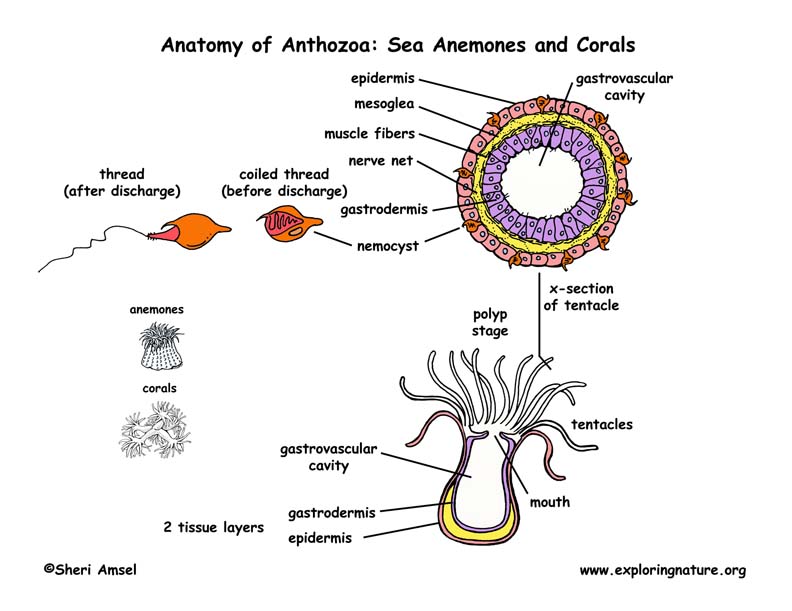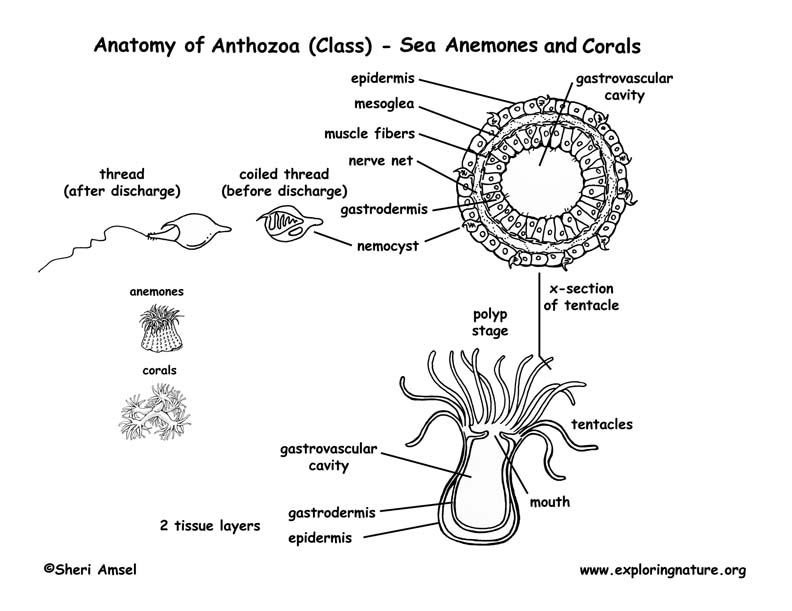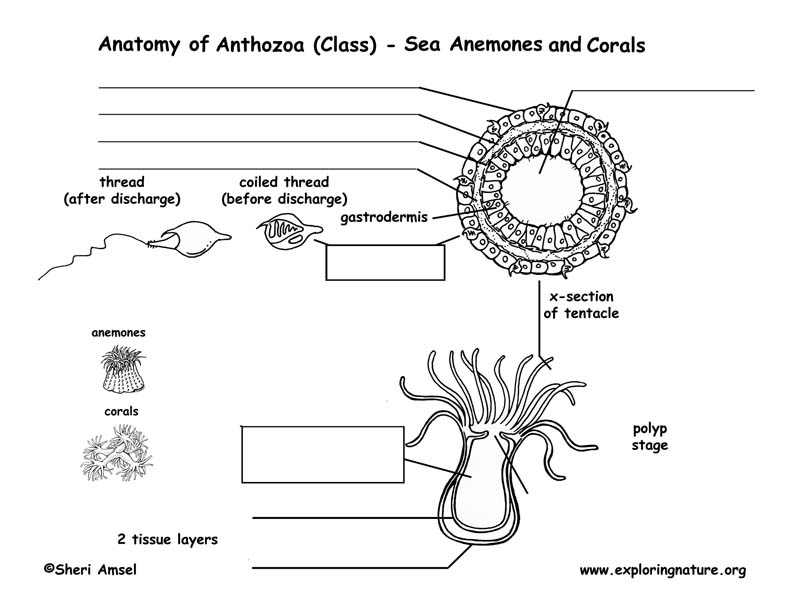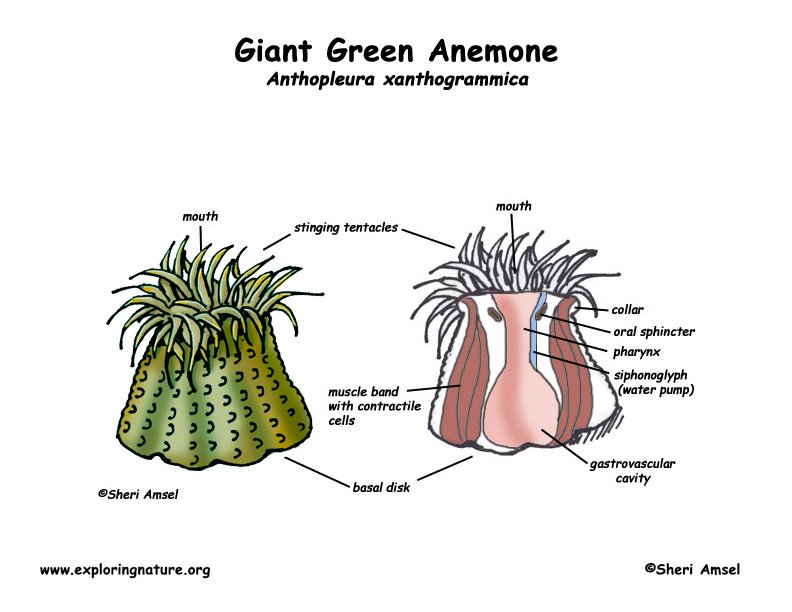

Range and Habitat: They are all aquatic and mostly found in shallow coastal waters, though some are found in freshwater locations.
Physical Traits (Anatomy): They have a “polyp” body form which, as adults, is usually anchored (sessile) with the mouth facing upward. Structurally, it is made up of a basal disc that attaches to the seabed and a cylindrical body stalk. Inside the body is the gastrovascular cavity. The mouth opens upward and is surrounded by tentacles. This is the dominant body form of the hydras, sea anemones and the corals. The Portuguese man-of-war is actually a gas-filled polyp that floats on the surface of the ocean trailing stinging polyps.
They have two cell layers – an outer protective epidermis and an inner gastrodermis. Between them is a jelly-like matrix called mesoglea. These layers surround an inner cavity called the gastrovascular cavity.
The epidermis layer is made up of many different types of cells. There are cells that contain muscles fibers (epitheliomuscular cells). These contract to allow the animal to move. Nerve cells make up a “nerve net” in the body that works with the muscle fibers to produce movement. There are also undifferentiated cells, called interstitial cells, that give rise to other cell types. Interstitial cells form eggs and sperm.
Interstitial cells also form cnidocytes in some species which are special fluid-filled cells called “stinging cells.” Inside each stinging cell sits a spiral fiber, called a nematocyst, that is coiled and ready to spring. If a stinging cell is touched, it triggers the nematocyst, which instantly uncoils to catch prey. Some also inject a toxin that paralyzes prey. Then the tentacles around the mouth move the prey inside where it is digested. In some species the cnidocyte cells contain spirocysts that are sticky threads that are used to catch prey or stick to surfaces. These are common in corals and sea anemones. There are also ptychocysts cells in some species, which help the animal anchor to the seabed.
The inner gastrodermis layer makes and secretes digestive fluids into the gastrovascular cavity where food is broken down and digested.
Habits (Behavior): When threatened, they will use their stinging cells to repel predators.
Diet: They are carnivores capturing prey as it drifts through their tentacles. Any contact triggers the discharge of stinging nematocysts that paralyze the prey. Then the tentacles will pull prey into the mouth and gastrovascular cavity. Once in the gastrovascular cavity, the gastrodermis cells secrete the digestive enzyme that breaks down the food. Waste is then ejected through the mouth with a sharp contraction of the body.
An example of Anthozoa, are the sea anemones which stay as polyps their whole lives embedded to the sea floor. Eggs and sperm are released into the water and fertilization results in free-swimming larvae, which embed on the sea floor and develop into a polyps. Sea anemones can also bud asexually.
Another Anthozoa, the corals, have many forms. Most are stony corals, which form calcium carbonate skeletons in the shape of a protective cup. The coral polyp will pull into the cup to take shelter. Collectively the corals are the stratum for coral reefs. Other than the more common stony corals are some “soft corals” that take on more of a mound shape without the hard calcium carbonate skeletons. Corals have a symbiotic relationship with an algae called zooxanthellae. Zooxanthella lives in the coral tissue itself, feeding the coral food and oxygen and taking up the carbon dioxide. Zooxanthella is what gives coral its many pretty colors. Zooxanthellae algae is very sensitive to pollution or water temperature changes. It will die and the coral loses its pretty colors. This is called coral bleaching. It is a sign of an unhealthy coral reef.
Coral is also killed by collectors. They harvest colorful corals and fish to sell to aquariums and shell trade markets. Visiting tourists, who go snorkeling on the reefs, walk on the fragile plants and animals. Boaters pollute the delicately balanced habitat. Our coral reefs are some of the most bio-diverse habitats left on Earth and need special protection.
______________________________________________________________________________________
They are found from Alaska to South America (Panama) and live in tidal pools on sandy and rocky shorelines, in areas where they are covered with water most of the time.
Their body is shaped like a column and is bright green in the sunlight. They can grow 6" wide (17 cm) and a foot tall (30 cm) with a 10-inch wide (25 cm) crown of tentacles. Tentacles grow in rows around the crown, often 6 or more rows. The tentacles have stinging cells called “cnidocytes” or “nematocytes” for paralyzing its prey. In the center of the tentacles is the “mouth” where food is taken in and wastes are pushed out.
They can move, though usually stay anchored to the rocks by their basal disk.
They eat mussels, sea urchins, small fish and crabs. First the animal happens by and is stung by the tentacles. The sting paralyzes it. Then it is pulled into the anemone’s “mouth,” at the center of all the tentacles.
Males and females release sperm and eggs into the water where fertilization occurs. Their eggs hatch into larvae that spread out and float around, settling into places where food can be found, like a mussel bed. Then they anchor and become adults.
When you research information you must cite the reference. Citing for websites is different from citing from books, magazines and periodicals. The style of citing shown here is from the MLA Style Citations (Modern Language Association).
When citing a WEBSITE the general format is as follows.
Author Last Name, First Name(s). "Title: Subtitle of Part of Web Page, if appropriate." Title: Subtitle: Section of Page if appropriate. Sponsoring/Publishing Agency, If Given. Additional significant descriptive information. Date of Electronic Publication or other Date, such as Last Updated. Day Month Year of access < URL >.
Amsel, Sheri. "Class - Anthozoa (Sea Anemones, Corals)" Exploring Nature Educational Resource ©2005-2025. January 13, 2025
< http://www.exploringnature.org/db/view/Class-Anthozoa-Sea-Anemones-Corals >




